Show HN: Mrkff – An Information Overload Management Tool https://ift.tt/3cnACP1
Show HN: Mrkff – An Information Overload Management Tool https://mrkff.com/ February 29, 2020 at 08:24PM
Labels: Hacker News
Feminist Artist / Blogger / Print on Demand designer BDSM/ Kink/ swingers lifestyle / power exchange relationship/ ethical non mono / open relationships/ sex postive
Show HN: Mrkff – An Information Overload Management Tool https://mrkff.com/ February 29, 2020 at 08:24PM
Labels: Hacker News
Show HN: Twelve Simple Algorithms to Compute Fibonacci Numbers https://ift.tt/389yGq7 February 29, 2020 at 02:44PM
Labels: Hacker News
Show HN: All-in-one peer tutoring management for schools https://tutorbook.app February 29, 2020 at 03:39PM
Labels: Hacker News
Show HN: Visualizing the transmission between you and base stations! https://ift.tt/32D2aLN February 29, 2020 at 01:13PM
Labels: Hacker News
Launch HN: Edtr.io – Intuitive web editor, open source and fully adaptable https://edtr.io February 29, 2020 at 11:11AM
Labels: Hacker News
Show HN: Coronavirus Spread Animation/Map https://ift.tt/39cGetp February 29, 2020 at 08:58AM
Labels: Hacker News
Show HN: Zé Faker – a CLI for generating Excel data https://ift.tt/2TiLOni February 28, 2020 at 11:57PM
Labels: Hacker News
Show HN: A Hitchhikers Guide to Asynchronous Programming https://ift.tt/2Vswtn3 February 28, 2020 at 06:23PM
Labels: Hacker News
This Weekend: Charity Marathons
Events: The winter rains have subsided, the holidays are a distant speck in the rearview mirror and it's now the time of year when events around the city become more prevalent. This weekend is a prime example as multiple events are scheduled, including the return of bonfire season at Ocean Beach from March 1 to October 31. Head to Union Square on Saturday for a free pick-your-own tulips event during American Tulip Day. On Sunday, the Hot Air Music Festival celebrates its 11th year with a celebration of contemporary music at the San Francisco For those looking to support a good cause as well as dive into the frigid waters of the Bay, head up to Aquatic Park for the 2020 Dash and Splash. On Sunday, the 42nd annual Chinese New Year YMCA Run will take place, benefiting the Chinatown YMCA Community Center. Be sure to check out all of the city's free monthly museum days, too, as each weekend presents new opportunities to visit one (or more!) of San Francisco's many museums for free. Read more about our featured events below.

The Chinatown YMCA on Sacramento Street on December 21, 2012. Photo credit: Don Barrett/Flickr.
Saturday, 10:30 a.m. to 1:30 p.m.
Aquatic Park
Spring may be soon upon us, but that doesn't mean the water around the city has gotten much warmer. This fact comes in handy for this Saturday's Dash and Splash, a 5K/10K race and polar plunge for charity. If that weren't already enough to set this event apart, participants are encouraged to don the wackiest costumes they can find or create while taking part in the plunge and the race. Proceeds and donations will support upwards of 24,000 Special Olympics athletes in year-round training, education and leadership programs.
How to Get There on Muni: Participants, costumes and all, may take the F Market and Wharves Line, as well as the 19 Polk, 28 19th Avenue, 30 Stockton, 47 Van Ness, or the 49 Van Ness/Mission routes to the area of the event in Aquatic Park.
Muni Service Notes: There are no planned service changes for this event.
Chinese New Year YMCA Run
Sunday, 8 to 9:30 a.m.
Chinatown
Now in its 42nd year, the Chinese New Year 5K/10K Run benefits the Chinatown YMCA Community Center, which serves more than a thousand youth and families of the surrounding neighborhoods.
Beginning at Sacramento and Grant streets, the race will take runners, joggers, and walkers along a scenic route through Chinatown, into North Beach, out along The Embarcadero, and then back into Chinatown to the finish line on Kearny Street between California and Sacramento streets.
How to Get There on Muni: Take the 1 California, 8 Bayshore, 10 Townsend, 12 Folsom/Pacific, 30 Stockton, 39 Coit, and 45 Union/Stockton routes as well as the California Cable Car Line to near the starting line at Grant and Sacramento avenues.
Muni Service Notes: The 10 Townsend and 12 Folsom/Pacific routes will have re-routes. The 1 California, 8 Bayshore, 30 Stockton, 39 Coit, 45 Union/Stockton routes and the California Cable Car Line may see minor delays near the race course.
Remember that you can take Muni for the entire day for a single $5 fare. The new $5 Day Pass, available on MuniMobile®, is part of Muni’s recent fare changes. The pass is intended to encourage a safe, convenient way to pay your fare and quickly board Muni vehicles, which reduces overall travel time for everyone. The $5 Day Pass is Muni bus, rail and historic streetcars only.
“On Tap” gives you a heads up about the big events in town and what Muni routes and lines will get you to the party. Look for this feature to be posted usually on Thursdays for a look ahead to the weekend. Check out our Weekend Traffic & Transit Advisory for more details.
Show HN: MakePip – Automatically Publish Python to PyPi https://ift.tt/2TkecFM February 28, 2020 at 09:59AM
Labels: Hacker News
Show HN: ENVy, a Development Environment Manager https://ift.tt/2wXupt5 February 28, 2020 at 09:45AM
Labels: Hacker News
Show HN: Pomodoro Calendar: custom printable planners for pomodoro technique https://ift.tt/39cfV6E February 28, 2020 at 10:23AM
Labels: Hacker News
Show HN: Derek – reduce fatigue by automating GitHub https://ift.tt/2vv3kH0 February 28, 2020 at 09:36AM
Labels: Hacker News
Show HN: Vuepack – fast and simple Snowpack/Vue project toolchain https://ift.tt/2SB6BDK February 28, 2020 at 06:36AM
Labels: Hacker News
Show HN: Profit Hunt - Get inspired by profitable online projects http://profithunt.co February 28, 2020 at 02:08AM
Labels: Hacker News
Show HN: A template to help you write your web project specs in less than 10mins https://ift.tt/2VpPjLD February 28, 2020 at 12:14AM
Labels: Hacker News
Show HN: Run your GitHub Actions locally https://ift.tt/2tKTin1 February 27, 2020 at 07:25PM
Labels: Hacker News
Muni's Unsung Heroes of Black History
Black History Month is a great opportunity to tell big important stories, but also to highlight the smaller, less noted stories of everyday people. This week, we're looking back through Muni history at a few people whose day-to-day achievements may not have made headlines but whose contributions nonetheless made a difference to breaking down racial barriers in San Francisco's transit industry.
In September 1950, Muni started the "Courtesy Citation" program to honor the hard work of Muni operators. Operators who received commendations from the public would be recognized in the railway's newsletter and entered into the running for "Muni Man of the Month", an award that brought greater recognition in the form of a $50 check and a special card featuring the winner's photo inside Muni vehicles.

Lilburn Delaney, conductor on the H Potrero streetcar, leans out the back platform of a car in this 1948 photo.
Right away, nominations came in for many black Municipal Railway transit operators who were recognized by riders for their excellent public service. Lilburn Delaney became the first African-American man to be given the honor of "Muni Man" in February 1951. Delaney started at Muni in September 1945 as a conductor on the H Potrero streetcar line and at the time of his award, was a trolley coach operator on the 5 McAllister.

Reginald Simpkins poses for a portrait at the Muni Photo Lab in this 1951 shot. Winners of the Muni Man award like Simpkins were honored with a $50 check and advertisements featuring their photo inside Muni vehicles.
Several months after Delaney, Reginald H. Simpkins was honored as top operator in September of that year. Simpkins, a driver on the 43 Roosevelt bus route, had no shortage of praise from riders on his bus. One letter noted how Simpkins "never loses his dignity or efficiency..." even during busy and stressful rush hour runs and "his sense of humor is so outstanding that it is a real pleasure to ride on his bus."

Beverly Hopkins (Right) and Helen Carson make repairs to a bus at Woods Division.
In June 1978, Beverly Hopkins became one of the first black women to join the maintenance crew at Woods Division. By the time of Beverly’s hiring in the late 1970s, the Muni staff newsletter says the eight newly hired women comprised the “largest number of female automotive service persons ever to work for Muni shops. The need was there and they were qualified.”

Evelyn Wells, Muni's first female Inspector poses while at work in the field in this 1979 shot.
Evelyn J. Wells holds the honor of being the first African American woman to be appointed as a Muni inspector (badge #54). As an inspector, she was responsible for supervising service, helping investigate accidents, and clearing up delays on bus and rail lines. Working previously as an N Judah operator, Wells began as an inspector in May 1979 at age 28.
These brief highlights barely begin to tell the full story of the contributions or struggles of people of color in San Francisco's public transit history. While much focus goes to major figures and big breakthroughs in history, the day in day out work of these "unsung heroes" went a long way to break down racial barriers within the industry.
Show HN: Browser extension that hides advertised results from Google search https://ift.tt/2vkvf2o February 27, 2020 at 12:22PM
Labels: Hacker News
Show HN: Ecosim – A cellular ecosystem simulator toy for Linux written in C https://ift.tt/2uF9Ela February 27, 2020 at 01:52PM
Labels: Hacker News
Show HN: Crumpled Papr https://ift.tt/32xObqB February 27, 2020 at 01:48PM
Labels: Hacker News
Show HN: Breezy – A Marketplace for Easily Finding the Best Pet Insurance https://sobreezy.com/ February 27, 2020 at 01:19PM
Labels: Hacker News
Launch HN: Probably Genetic (YC W19): At-home DNA testing for every gene Hi Hacker News, We’re Harley and Lukas from Probably Genetic. We built an at-home physician-ordered DNA test that covers all genes and looks for pathogenic variants related to thousands of rare genetic conditions. Why rare genetic conditions? It may seem like a niche problem but there are ~400 million people worldwide with a rare genetic condition, half of which are currently undiagnosed. To put this into perspective, it’s estimated that 1 in 10 Americans has a rare condition and while each of the individual ~10,000 conditions is rare, the population that suffers such conditions is larger than cancer and HIV combined. Furthermore, for the patients that have been diagnosed, it takes on average 8 years for doctors to identify their conditions. You’ve already heard of rare genetic conditions, you might just not be aware of it. Remember the Ice Bucket Challenge for ALS? Most of these diseases initially look like more common conditions, such as autism, chronic pain, ADHD, or even the flu, before patients get worse. This diagnostic odyssey can be extremely costly for patients and in our experience, some are spending more than $30,000 and seeing more than 10 doctors before they get access to the right specialists and testing. We have seen this problem first-hand. Lukas is a rare-disease expert and worked on the world’s largest rare disease project (the 100,000 genomes project) as a PhD candidate at Oxford University in the UK. I am trained as a theoretical computational astrophysicist and during my PhD and fellowship at Cambridge University and Oxford University, I spent my spare time working with National Healthcare Service doctors developing and publishing medical diagnostics with machine learning. Our original idea was actually slightly different from what we have now. We spent a lot of effort on developing a symptom checker specifically for rare conditions with the idea to comb through existing medical records and flag patients with potential rare genetic conditions because, unsurprisingly, WebMD and others aren't really great for this purpose. As we were building this, we realized that for the patients we worked with, even if their symptoms were suggestive of a genetic condition, access to clinical-grade genetic testing was extremely difficult for many as it was either too expensive because insurance wouldn’t cover the cost, or they couldn’t find a doctor that would order it. Thus, we decided to use our expertise to both find these patients more efficiently and built up a service to drastically reduce the time and cost to access clinical-grade genetic testing. About the test: Just like most DNA tests, you can do this from home and it’s noninvasive, all we need is a little saliva. Unlike most DNA tests, ours is physician-ordered, sequenced in a CLIA-accredited and CAP-certified lab, the results are signed out by a licensed clinical lab director, all users have access to genetic counseling, and we try to incorporate as much phenotypic data as possible into the analysis. Our product is a whole-exome sequencing test with 100x coverage and covers all of the more than 20,000 genes, where 85% of known disease-causing variants occur. People always ask, how are you different from 23andme? Looking for a rare genetic condition is kind of like trying to find a typo in a novel. Using a 23andme (or similar) test to look for such a condition is like trying to find a typo in the first Harry Potter novel and stopping after 75 words. Those tests are just not meant for this purpose. Most are based on genotyping arrays that look for very specific variants at predetermined locations in the genome. However, the variants that cause rare diseases can occur anywhere. For example, there are over 1,700 different mutations in the CFTR gene that can cause cystic fibrosis. Approximately 85% of the known pathogenic mutations occur in the protein-coding regions of DNA called the exome. Our test is a whole exome sequencing test rather than a genotyping array, which allows us to cover all of the genes in a person’s DNA. We often get the question, why not do whole genome rather than whole exome? Right now it simply comes down to accessibility. For most consumers, whole genome sequencing is still too expensive and the additional gain in terms of coverage of pathogenic mutations doesn’t necessarily warrant the significant price increase. That being said, if you are interested in clinical-grade whole genome sequencing, we can soon offer this as well. Patient privacy is a huge concern for us and something we think about all the time. Quite simply, we will never share any of our users' data without explicit consent and we are more than happy to both delete our users' data and destroy their sample if requested. Interestingly, we often have the opposite problem where we receive inbound requests of people trying to share their data with us to see if we can help them. Out of the more than 10,000 rare diseases, over 95% do not have an FDA-approved treatment, which is why the rare disease community is so motivated to leverage their personal insights. We have started a waitlist to provide such services and are actively seeking ways to help these people and integrate them into our community, even if they have not had sequencing through us. Finally, how much does it cost? A single test right now costs $899 on our website, but we try to offer the test in trios where we sequence both the patient and two family members as this often gives a higher diagnostic yield. The latter option is $1,799. We expect that the test price will decrease significantly with time as the cost of sequencing drops and more of the analysis can be automated. We don’t currently accept insurance; however, in our experience, using more traditional channels to access this kind of testing can result in bills of >$10,000, not all of which may be covered. Many insurance providers don’t even cover this kind of testing, except for very specific purposes, despite more and more of the medical literature recommending exome sequencing as a first-tier diagnostic for specific indications. Ideally, we would make the product so affordable that it simply makes sense to use us rather than billing insurance for the test plus the numerous doctor and specialist visits needed before and after it’s ordered. We are currently offering the test at cost, as we aim not to profit off of the patients that need it most, and this is sustainable because, with the consent of the patients, we can leverage our data asset for drug discovery, clinical trial recruitment, and drug repurposing. Consumer genetic testing is growing rapidly as an industry and nearly doubling every single year. What is missing from this market is accessible physician-ordered testing that can genuinely help those with complex symptoms and undiagnosed genetic conditions. This is what we hope to provide. If you have any questions or feedback, we would love to hear it and please check us out at probablygenetic.com. February 27, 2020 at 12:17PM
Labels: Hacker News
Show HN: Pep – Turn Your Website into a Progressive Web App https://pep.dev/ February 27, 2020 at 12:02PM
Labels: Hacker News
Show HN: Airlist – A nested outliner with Omnifocus like dates/perspectives https://airlist.app February 27, 2020 at 11:56AM
Labels: Hacker News
Show HN: Goodreads Data Pipeline https://ift.tt/39WCoVc February 27, 2020 at 09:41AM
Labels: Hacker News
Show HN: SocialPlanner – Find, plan and post content, all in one place https://ift.tt/2Q9jDqy February 27, 2020 at 11:05AM
Labels: Hacker News
Show HN: Selling side project that displays remote jobs daily and tweets daily https://remotepad.io/ February 27, 2020 at 09:34AM
Labels: Hacker News
Show HN: A truly open source modern headless CMS https://ift.tt/38SX5kY February 27, 2020 at 08:14AM
Labels: Hacker News
Show HN: Anomaly Detection in Ruby https://ift.tt/2vQiCMk February 27, 2020 at 07:26AM
Labels: Hacker News
Show HN: New Profile Designs https://ift.tt/3a8ovU7 February 27, 2020 at 03:41AM
Labels: Hacker News
Show HN: Axomark – Shareable Anonymous Bookmarks http://axomark.xyz/ February 27, 2020 at 06:43AM
Labels: Hacker News
Show HN: Twitter lists for YC 2017, YC 2018, YC 2019 companies These are all participating founders. It is a great way to learn what they are all up to now: * YC S2017 https://twitter.com/i/lists/1230735563034021893 * YC W2017 https://twitter.com/i/lists/1230735739861618691 * YC S2018 https://twitter.com/i/lists/1230734925881470976 * YC W2018 https://twitter.com/i/lists/1230735246502424577 * YC S2019 https://twitter.com/i/lists/1230728767556833280 * YC W2019 https://twitter.com/i/lists/1230734559743922178 Also: * YC S2020 https://twitter.com/i/lists/1230850014617862145 (will be populated in the future) * YC W2020 https://twitter.com/i/lists/1230849940101844999 (will be populated in the future) February 27, 2020 at 06:34AM
Labels: Hacker News
Show HN: An ElasticSearch Powered React DataGrid Template https://ift.tt/2vo8dYD February 27, 2020 at 01:37AM
Labels: Hacker News
Show HN: Metomic Contextual Consent – a privacy layer under embedded content https://ift.tt/3cd3MQZ February 27, 2020 at 04:54AM
Labels: Hacker News
Show HN: My Fork Of A YouTube Streaming/Download App For PPC Mac OS X https://ift.tt/3943vxN February 26, 2020 at 10:35PM
Labels: Hacker News
Show HN: Free PDF: Creative Coding for Kids https://ift.tt/2vjRGVy February 26, 2020 at 07:59PM
Labels: Hacker News
Show HN: Base24 binary-to-text encoding for humans https://ift.tt/2PsC8FH February 26, 2020 at 08:29PM
Labels: Hacker News
Show HN: (crocs) Python2Regex and Yacc-like. Parsing with no steroids in Python https://ift.tt/2uEaPfT February 26, 2020 at 06:55PM
Labels: Hacker News
Show HN: Crypto Crumple Zones: Enabling Limited Access Without Mass Surveillance [pdf] https://ift.tt/2T5YsHL February 26, 2020 at 06:07PM
Labels: Hacker News
Results Are In – How Should We Explore Extending The Central Subway?
The Central Subway is set to open in summer 2021 and will connect some of the city’s densest neighborhoods and job centers. It is expected to carry tens of thousands of riders everyday from Chinatown, through Union Square and SoMa before linking up with the current above-ground T Third line near the 4th/King Caltrain Station and on to Mission Bay, the Bayview, and Visitacion Valley.
While this new line will be vital for San Francisco’s growing population and workforce, we know that now is the time to continue planning for the future.
In order to better understand the needs and goals of the community, we held open house meetings and developed an online survey to gauge interest and explore potential ways to extend the Central Subway. This online survey built on the prior 2015 feasibility study results and previous community meetings on the topic.
This interactive survey was given in English, Spanish and Chinese, and allowed users to drop markers in places where they thought subway stations should be analyzed. We were thrilled that the combination of interest in a new subway plus the ease of the survey technology on the web and mobile (thanks MetroQuest!) resulted in over 8,000 responses – a record for the SFMTA!
In general, the results showed that most people favored extending the subway to North Beach. It also showed clusters of interest in new connections near Fisherman’s Wharf, at the soon-to-be-complete Van Ness BRT and in the Marina neighborhood.
Results
After analyzing all 8,137 paper and online responses, which generated over 148,000 data points and 13,000 comments, we compiled the below graphics to summarize the results:
How do you currently get around San Francisco?
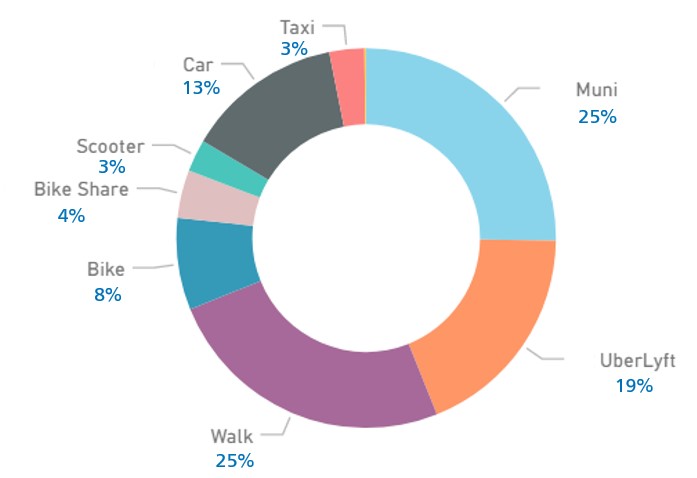
Typical travel choices of those that took the survey. Half of respondents regularly take Muni or walk. Most of those that take Muni do so 4 times per week or more.
Which transportation goals would you like to see prioritized?
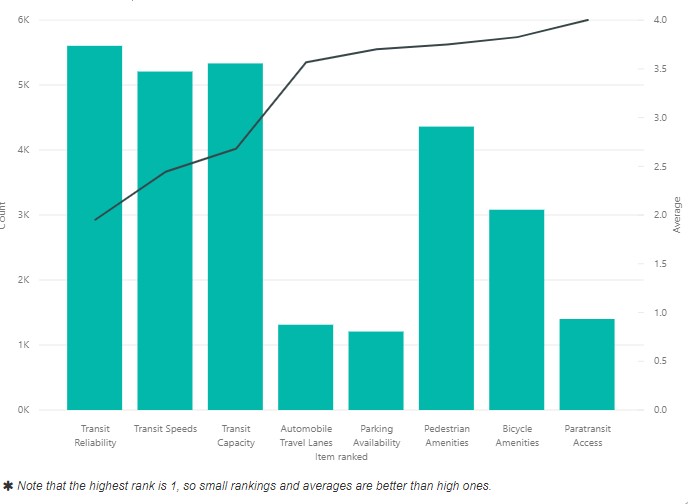
Transit related goals were ranked as the three highest.
Would an extension of the Central Subway help meet your transportation goals?
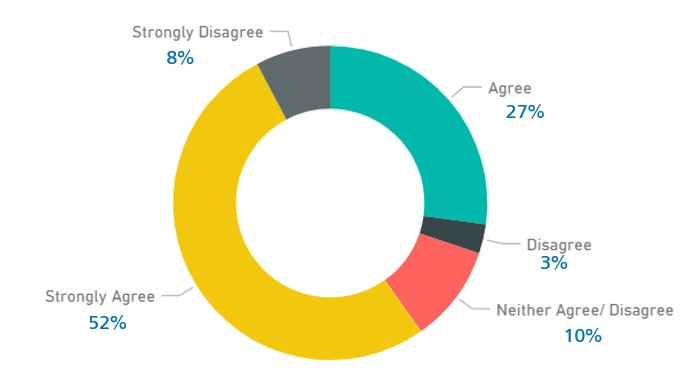
When asked if an extension of would help people meet their transportation needs, 79% either agreed or strongly agreed.
Should Central Subway be extended to North Beach using existing tunnels, with a new station near Washington Square?
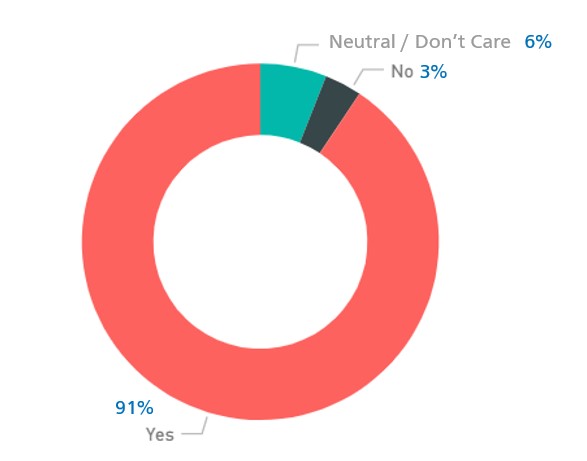
A large majority of people expressed a desire for a station in North Beach.
If the train extended from North Beach to Fisherman’s Wharf, would you prefer surface or underground?
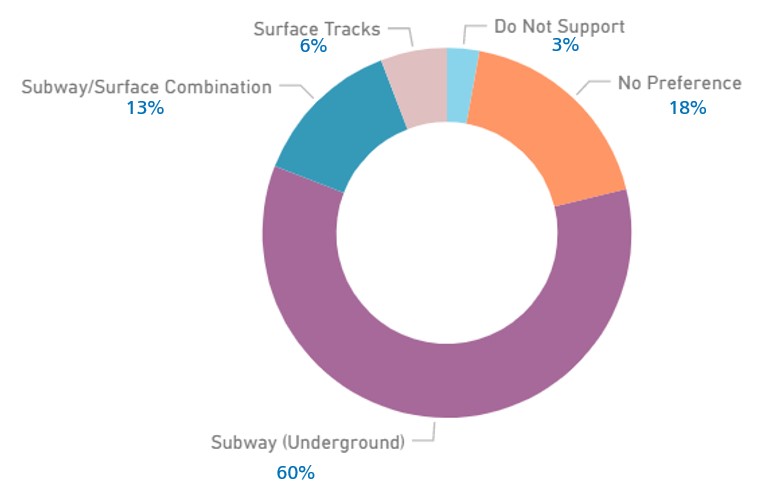
Most survey-takers indicated a preference for underground transit.
If the train extended from Fisherman’s Wharf towards Marina/Cow Hollow, would you prefer surface or underground?
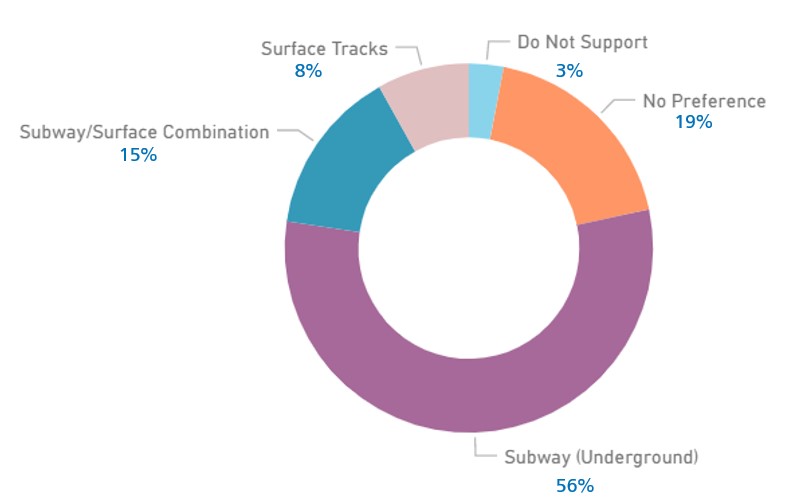
As with the previous question, most respondents preferred any extension to Marina/Cow Hollow be underground.
Where would you like to see new subway stations?

When compiling all the suggested station locations, clusters started to emerge, as shown in the above map.
Where do you live?
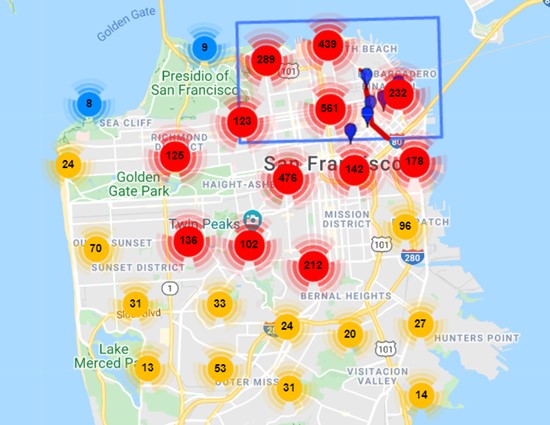
We received responses from all over the city with a high percentage people weighing in from inside the study area (blue box).
Where do you live?
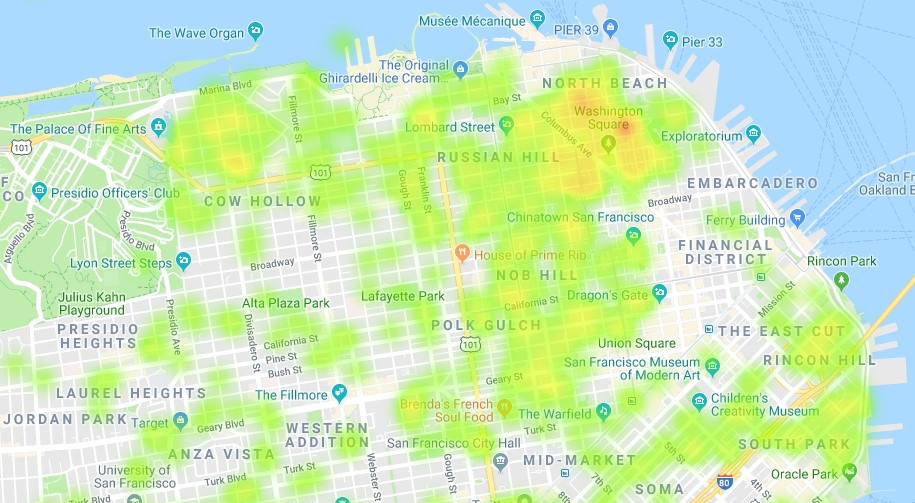
Zoomed in “home” view near the study area: Orange and red areas denote higher concentrations of responses.
Where do you work?
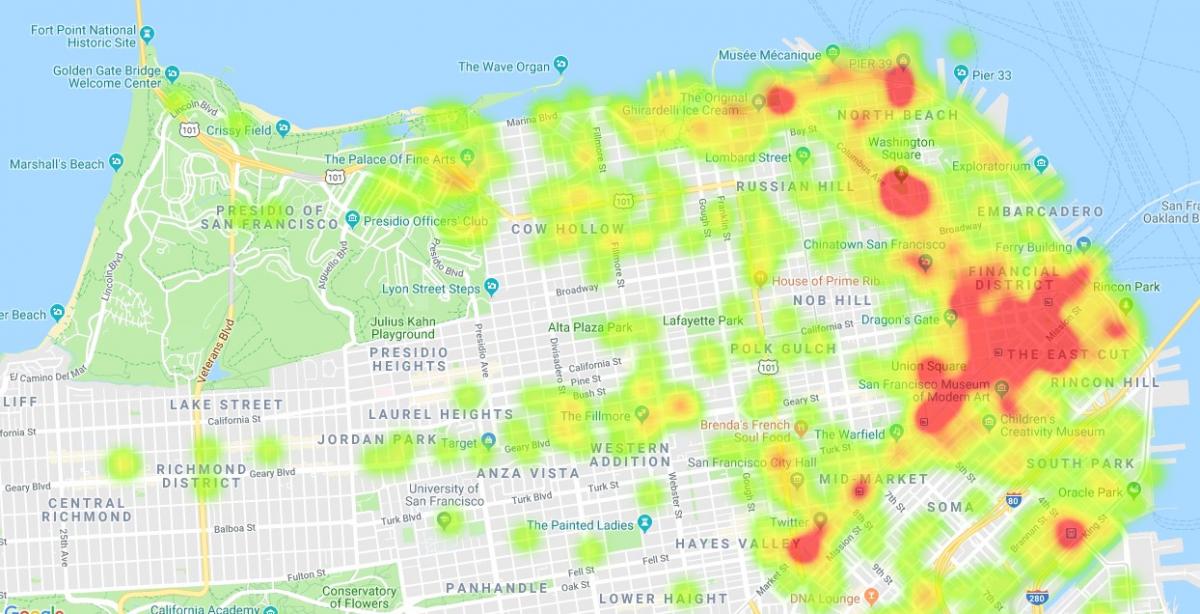
Orange and red areas denote higher concentrations of responses.
Next Steps
After compiling and further analyzing this feedback, we will begin looking at some potential extension routes from an engineering standpoint to better understand the potential trade-offs and benefits. We will reach out again to share them with the community for additional input. Our goal will be to narrow the options to two or three for further planning, environmental review, and design, contingent on identification of funding.
More Information
For more information, visit the Central Subway Extension project page where you can sign up for email updates.
Show HN: AsOne – Reddit and Patreon for Research https://asone.ai February 26, 2020 at 12:57PM
Labels: Hacker News
Show HN: Find public pianos around the world https://pianos.pub/ February 26, 2020 at 10:16AM
Labels: Hacker News
Show HN: Inline, Promise based wrapper around JavaScript Web Workers https://ift.tt/32sDaXE February 26, 2020 at 11:01AM
Labels: Hacker News
Show HN: OpenSourceWeekly.org – The best open source projects, curated by hand https://ift.tt/2TgGdhB February 26, 2020 at 09:53AM
Labels: Hacker News
Show HN: Remote Contract Only Job Board https://ift.tt/2Tg6koF February 26, 2020 at 11:15AM
Labels: Hacker News
Show HN: Runnaroo – A new web search engine In the sprit of releasing to the public early, I would like to share a search engine/portal I have been building in my spare time: https://ift.tt/2T4emlT Why: I started to not be able to easily tell the different between ads and organic search results in other search engines (even on DuckDuckGo), and I have been disappointed with recent UI changes in a lot of the major search engines. My main guiding rule when adding features has been to ask, "is it better for the user?" Important to know: I still believe Google currently returns the most relevant web results, so like StartPage I use Google's index as the base of the web results. Some interesting features: Deep Searching - The inclusion of relevant results from different vertical specific search engines depending on the search query. For example, if a user searches for 'python jobs NY', results from Indeed.com will be pulled in. The long term plan is to connect into the best vertical information sources for each type of query. Quick Directs - Automatic redirects for a limited number of commonly searched terms (facebook, google, etc.). This is similar to the Google "Feeling Lucky" button, but done by default. I found that most of the searches I did in Google were navigational. It's simple, but surprisingly has been the thing to resonate with normal (non-technical) users. Strict Search - Optional selection to force all the search terms in the query to be present in the web results. Full URL paths - The full URL path of the result is available on the SERP under a toggle. Privacy - The site doesn't do any tracking. There will most likely be a need to put some things in place at some point to prevent abuse, but user search data will never be used for ad tracking. The number of things I still have to add to the site is incredibly long, but I have gotten to the point where I have switched over to using it full time as my default search engine. February 26, 2020 at 07:18AM
Labels: Hacker News
Show HN: Opensource.builders, open-source alternatives to commercial software https://ift.tt/2vh4bkA February 26, 2020 at 11:25AM
Labels: Hacker News
Show HN: SpectX launches the free edition of its raw log file / blob analyzer https://ift.tt/2VnWXpN February 26, 2020 at 10:50AM
Labels: Hacker News
Show HN: Magit for VSCode (Alpha) https://ift.tt/2uBo9X8 February 26, 2020 at 10:20AM
Labels: Hacker News
Show HN: Chops – Make beats with your voice https://ift.tt/2vlF8ge February 26, 2020 at 10:01AM
Labels: Hacker News
Show HN: Spectroomz – Freelancing Platform for Autistics and Aspies https://ift.tt/37XOGLL February 26, 2020 at 08:18AM
Labels: Hacker News
Show HN: Just One Earth – Bite sized climate existentialism https://justone.earth/ February 26, 2020 at 07:48AM
Labels: Hacker News
Show HN: Changelog.gy – A changelog page for all your products https://changelog.gy February 26, 2020 at 07:01AM
Labels: Hacker News
Show HN: Writing Maintainable Unit Tests Course https://ift.tt/2HVujV9 February 26, 2020 at 03:58AM
Labels: Hacker News
Show HN: GitHub's tree-sitter meets Docker https://ift.tt/32tK9Qj February 26, 2020 at 03:36AM
Labels: Hacker News
Show HN: Telegram Bot Wrapper for the Rubygems.org API https://ift.tt/3c7tq9H February 26, 2020 at 03:33AM
Labels: Hacker News
Show HN: Word Champions, a word game written in ClojureScript https://ift.tt/37wuD7p February 26, 2020 at 06:31AM
Labels: Hacker News
Show HN: PyTorch C++ Tutorials from Beginner to Advanced https://ift.tt/2NrTimo February 25, 2020 at 09:04PM
Labels: Hacker News
Show HN: NestDrop – realtime VJ engine using Milkdrop https://ift.tt/2Pd0L9d February 25, 2020 at 04:18PM
Labels: Hacker News
Show HN: Killed for Food https://ift.tt/37ToG4c February 25, 2020 at 09:37PM
Labels: Hacker News
Show HN: Querying JSON documents using SQL-like language in Scala https://ift.tt/32ppnRy February 25, 2020 at 02:31PM
Labels: Hacker News
Show HN: My self hosted project management and billing app (Trello alternative) http://duetapp.com February 25, 2020 at 07:51AM
Labels: Hacker News
Show HN: Helium – Lighter web automation based on Selenium https://ift.tt/2HXgSnz February 25, 2020 at 01:15PM
Labels: Hacker News
Show HN: A (very) simple proof-of-work blockchain written in Rust https://ift.tt/2Pomvzc February 25, 2020 at 12:37PM
Labels: Hacker News
Show HN: Hyperdoc - We make code walkthrough guides (Moment.js) https://ift.tt/2wNMzxh February 25, 2020 at 12:25PM
Labels: Hacker News
Show HN: EasyLlama – Sexual Harassment Training Made Easy (Required in NY/CA/IL) https://ift.tt/32vhs5w February 25, 2020 at 12:30PM
Labels: Hacker News
Show HN: Yes and No design studio – We solve design problems for startups https://xn--bj8a.com February 25, 2020 at 12:00PM
Labels: Hacker News
Show HN: Shox: A customisable status bar for your terminal https://ift.tt/2PoiZER February 25, 2020 at 11:21AM
Labels: Hacker News
Show HN: Generate fake UI design clients to practice UI design https://ift.tt/391ajMz February 25, 2020 at 08:41AM
Labels: Hacker News
Show HN: Web-based Babel alternative for React/JSX (ultra-fast and tiny 5.1 kB) https://ift.tt/2HOBwGq February 24, 2020 at 09:02PM
Labels: Hacker News
Show HN: Hacker News Rankings https://ift.tt/2OQTwC2 February 25, 2020 at 03:50AM
Labels: Hacker News
Show HN: Mount S3 cloud storage directly to Windows Explorer [New link within] https://ift.tt/2wNNeip February 25, 2020 at 03:06AM
Labels: Hacker News
Show HN: Decentralized Automation Framework in YAML https://starsheep.io February 25, 2020 at 01:52AM
Labels: Hacker News
Show HN: TribePulse – more thoughtful internal discussion platform for teams https://ift.tt/2NsYFDJ February 24, 2020 at 06:48PM
Labels: Hacker News
Show HN: AiDee – a open source micro-framework for Touch ID and Face ID https://ift.tt/398hmTy February 24, 2020 at 05:16PM
Labels: Hacker News
Show HN: Back pain triage web-app, solution MVP https://ift.tt/37ZZSr7 February 24, 2020 at 04:47PM
Labels: Hacker News
Reminder: Service Changes Now in Effect
This past Saturday, the San Francisco Municipal Transportation Agency (SFMTA) made several changes to improve Muni service. These changes will improve reliability and connections, reduce crowding and provide one-seat rides for weekend early morning Metro service with bus substitutions. Affected routes include the J, KT, L, M and N Metro lines, 7 Haight-Noriega, 23 Monterey, 1AX, 1BX, 31AX, 31BX, 38AX, and 38BX.
To reduce the need for transfers during early weekend morning service, all metro lines will be served by bus after the end of Owl service and before Metro stations open. Metro stations open at 6 a.m. on Saturday and 8 a.m. on Sundays. The new early morning metro bus will be a one-seat ride to your destination.

To reduce overcrowding and increase transit reliability on weekdays, the 7 Haight/Noriega will begin running 60-foot buses. Adding bigger buses to weekday service will provide Muni customers more seats and comfort during morning and evening commutes.
Due to construction at SFPUC’s Southeast Treatment Plant, the 23 Monterey will be rerouted from Jerrold to Palou between Toland and Phelps. New bus stops will align with the 24 Divisadero.

The last runs of the day for Muni’s evening Richmond Express service will change, which includes the 1AX, 1BX, 31AX, 31BX, 38AX, and 38BX. Customers are advised to check schedules and note alternate routes. For customers traveling outbound at 7:00 p.m., alternate routes include the 1 California on Davis and Sacramento streets or the 38 Rapid at Fremont and Market streets.

Please pay attention to Muni Alert signs for instructions or look for Muni ambassadors near the affected bus route stops to answer your questions.
As Muni prepares to update the 12 Folsom/Pacific route to travel through Rincon Hill, we've been keeping a close eye on construction on Folsom Street. Although the Transbay Folsom Streetscape Improvement Project is making progress, conditions on Folsom east of 2nd Street are not yet ready to serve the 7,000 daily customers who ride the 12 Folsom/Pacific. If construction proceeds at the current pace, we anticipate launching the new route in Spring 2020
To learn more, please visit the project page.
Show HN: AirPPT – Go from PowerPoint to HTML/CSS UI in Seconds https://ift.tt/2KMZVzz February 24, 2020 at 02:00PM
Labels: Hacker News
Show HN: Py package to collect normalized news from (almost) any website https://ift.tt/37YJFTc February 24, 2020 at 02:02PM
Labels: Hacker News
Launch HN: Syndetic (YC W20) – Software for explaining datasets Hi HN, We're Allison and Steve of Syndetic ( https://ift.tt/32nmmRL ). Syndetic is a web app that data providers use to explain their datasets to their customers. Think ReadMe but for datasets instead of APIs. Every exchange of data ultimately comes down to a person at one company explaining their data to a person at another. Data buyers need to understand what's in the dataset (what are the fields and what do they mean) as well as how valuable it can be to them (how complete is it? how relevant?). Data providers solve this problem today with a "data dictionary" which is a meta spreadsheet explaining a dataset. This gets shared alongside some sample data over email. These artifacts are constantly getting stale as the underlying data changes. Syndetic replaces this with software connected directly to the data that's being exchanged. We scan the data and automatically summarize it through statistics (e.g., cardinality), coverage rates, frequency counts, and sample sets. We do this continuously to monitor data quality over time. If a field gets removed from the file or goes from 1% null to 20% null we automatically alert the provider so they can take a look. For an example of what we produce but on an open dataset check out the results of the NYC 2015 Tree census at https://ift.tt/38UuiMN... . We met at SevenFifty, a tech startup connecting the three tiers of the beverage alcohol trade in the United States. SevenFifty integrates with the backend systems of 1,000+ beverage wholesalers to produce a complete dataset of what a restaurant can buy wholesale, at what price, in any zipcode in America. While the core business is a marketplace between buyers and sellers of alcohol, we built a side product providing data feeds back to beverage wholesalers about their own data. Syndetic grew out of the problems we experienced doing that. Allison kept a spreadsheet in dropbox of our data schema, which was very difficult to maintain, especially across a distributed team of data engineers and account managers. We pulled sample sets ad hoc, and ran stats over the samples to make sure the quality was good. We spent hours on the phone with our customers putting it all together to convey the meaning and the value of our data. We wondered why there was no software out there specifically built for data-as-a-service. We also have backgrounds in quantitative finance (D. E. Shaw, Tower Research, BlackRock), large purchasers of external data, where we've seen the other side of this problem. Data purchasers spend a lot of time up-front evaluating the quality of a dataset, but they often don’t monitor how the quality changes over time. They also have a hard time assessing the intersection of external datasets with data they already have. We're focusing on data providers first but expect to expand to purchasers down the road. Our tech stack is one monolithic repo split into the frontend web app and backend data scanning. The frontend is a rails app and the data scanning is written in rust (we forked the amazing library xsv). One quirk is that we want to run the scanning in the same region as our customers' data to keep bandwidth costs and transfer time down, so we're actually running across both GCP and AWS. If you're interested in this field you might enjoy reading the paper "Datasheets for datasets" ( https://ift.tt/3c494hD ) which proposes a standardized method for documenting datasets modeled after the spec sheets that come with electronics. The authors propose that “for dataset creators, the primary objective is to encourage careful reflection on the process of creating, distributing, and maintaining a dataset, including any underlying assumptions, potential risks or harms, and implications of use.” We agree with them that as more and more data is sold, the chance of misunderstanding what’s in the data increases. We think we can help here by building qualitative questions into Syndetic alongside automation. We have lots of ideas of where we could go with this, like fancier type detection (e.g. is this a phone number), validations, visualizations, anomaly detection, stability scores, configurable sampling, and benchmarking. We'd love feedback and to hear about your challenges working with datasets! February 24, 2020 at 12:08PM
Labels: Hacker News
Show HN: Asynq – Simple, reliable, and efficient distributed task queue for Go https://ift.tt/30vyMGf February 24, 2020 at 05:05AM
Labels: Hacker News
Show HN: Neo.mjs, the webworkers driven UI framework https://ift.tt/2STc5d7 February 24, 2020 at 03:40AM
Labels: Hacker News
Show HN: City Filter – Travel to the Right Cities at the Right Time https://ift.tt/2Phu0HZ February 24, 2020 at 08:11AM
Labels: Hacker News
Show HN: Bubblemon, System load meter for human beings https://ift.tt/38WgUIf February 24, 2020 at 07:53AM
Labels: Hacker News
Show HN: An Online Personal Organizer https://ift.tt/32wTeYF February 24, 2020 at 05:09AM
Labels: Hacker News
Show HN: Java full-stack starter template for side projects https://ift.tt/2vXsgNp February 23, 2020 at 07:13PM
Labels: Hacker News
Show HN: LinkedIn for Chatbots https://presbot.com/ February 23, 2020 at 09:37PM
Labels: Hacker News
Show HN: Damnshort – dotcoms for startups and side projects https://damnshort.com February 23, 2020 at 11:32AM
Labels: Hacker News
Show HN: Netboot diskless Windows machines from a Linux server for LAN parties https://ift.tt/32cySU5 February 23, 2020 at 03:19PM
Labels: Hacker News
Show HN: Memoly, a subscription manager app built without code Hey HN community, I'm Sebastian, a Product Manager/Designer/Maker. I'd like for anyone with an idea to build and validate something quickly. I got into the #nocode thing earlier last year and wanted to see what's possible with the tools out there today. Over the last few months, I spent a lot of late nights and weekends on my side project. I'm very proud to present the result today. Meet Memoly (https://memoly.app). It's built entirely without code. To achieve my goal, I used this tech stack: Adalo, Zapier, Airtable, and Carrd. Memoly is available for iOS and Android. I came up with the idea to solve my own pain point. I have way too many subscriptions! When I forgot to cancel on time for a yearly plan, that renewal was costly. I wanted to create something that helps me to keep track of my spendings. Would love to hear your thoughts! Cheers, Sebastian February 23, 2020 at 06:03AM
Labels: Hacker News
Show HN: Self Managed Link Aggregator https://ift.tt/2us5cWM February 23, 2020 at 02:23PM
Labels: Hacker News
Show HN: JAI: A Lego-Style Deep Learning Library on PyTorch https://ift.tt/2SOryLt February 23, 2020 at 12:39AM
Labels: Hacker News
Show HN: Search code in GitHub repos using regular expressions https://grep.app February 23, 2020 at 07:53AM
Labels: Hacker News
Show HN: Proxyman – native HTTP/HTTPS requests observation and manipulation app https://proxyman.io/ February 22, 2020 at 08:33PM
Labels: Hacker News
Show HN: Unbounded – Programmable NoSQL Data store https://ift.tt/38tSDZR February 22, 2020 at 01:42PM
Labels: Hacker News
Show HN: GitSpo – Monitoring and Analytics for Open-Source Projects http://gitspo.com/ February 22, 2020 at 02:59PM
Labels: Hacker News
Show HN: Single-Instruction (Subleq) Programming Game https://ift.tt/39WGU6c February 22, 2020 at 01:56PM
Labels: Hacker News
Show HN: WeKeep – A spreadsheets-first accounting software https://www.wekeep.co February 22, 2020 at 02:18PM
Labels: Hacker News
Show HN: AntiVirus Monitor – GitHub Action to combat false positives https://ift.tt/2Vd5v2I February 22, 2020 at 05:24AM
Labels: Hacker News
Show HN: Epictopus, a Collaborative Writing Platform http://epictopus.ml/ February 22, 2020 at 08:30AM
Labels: Hacker News
Show HN: Provision and automate cloud hosts with Go https://ift.tt/39SxIQn February 22, 2020 at 05:11AM
Labels: Hacker News
Show HN: Parallel – a simple Go parallel processing library https://ift.tt/2SZguK8 February 22, 2020 at 07:43AM
Labels: Hacker News
Show HN: MindForger Markdown editor just got live preview https://ift.tt/32fqcfM February 22, 2020 at 12:53AM
Labels: Hacker News
Show HN: Inlets PRO Is a Cloud Native Tunnel for L4 TCP Traffic https://ift.tt/2HLDmrw February 22, 2020 at 02:39AM
Labels: Hacker News
Show HN: Strategr – cross-platform time management application written in C++ https://ift.tt/37SMntf February 21, 2020 at 10:51PM
Labels: Hacker News
Show HN: A first project in Rust – in-memory order book https://ift.tt/38OOrnJ February 21, 2020 at 09:36PM
Labels: Hacker News
Show HN: TVnfo – Television Information https://tvnfo.com/ February 21, 2020 at 02:24PM
Labels: Hacker News
Director of Transportation Report: February 18, 2020

In this week’s Director’s Report from the SFMTA Board of Directors meeting, Jeffrey Tumlin gave updates on the following topics:
Washington, DC Visit
Muni Service Change
Black History Month
Church Station Elevator Upgrades
Our Board of Directors meeting is usually held on the first and third Tuesdays of each month. To watch the meeting in full, go to SFGovTV.
Show HN: Free startup ideas, analysis, validation and first steps I started a newsletter sending out daily startup ideas. After a year, I transitioned to weekly ideas with more in-depth details. I recently posted all of them to the website and made them searchable. Check it out and let me know what you think. By providing more than just an idea, my hope is to help someone start their next business. https://ift.tt/2sLlCEU February 21, 2020 at 02:51PM
Labels: Hacker News
Show HN: MDAnki – convert Markdown to Anki cards https://ift.tt/2uiVu90 February 21, 2020 at 12:23PM
Labels: Hacker News
Launch HN: Freshpaint (YC S19) – an automated, retroactive Segment alternative Hello HN! We’re Fitz & Malis, the founders of Freshpaint (YC S19) ( https://ift.tt/2ZVYN18 ). Our product is a more flexible way of setting up your analytics and marketing tools. With our javascript snippet, Freshpaint automatically instruments your site by tracking every behavior for you, up front. From there, you can create events for behaviors like clicks, pageviews, etc either through a point-and-click interface or code (whichever you’re more comfortable with). In one click, Freshpaint sends data collected for that event – past or present – to 80+ analytics or marketing tools. What does retroactive mean? Install Freshpaint’s snippet today. In 6 months start tracking something new, and you'll have the last 6 months worth of data that our product has already collected. We make it easy to backfill that historical data into your tools. There’s two types of people that get the most value out of Freshpaint: 1. The developer that owns data infrastructure at their company, and wants to lighten the load through automation. 2. The non-technical marketer/customer success/PM (or founder!) that makes use of the tools that require customer data. We both met while working at Heap (YC W13) – Malis led the database team and Fitz led product marketing. When starting Freshpaint, we were inspired by a phenomenon we saw while working with customers at Heap. Even though they used Heap for analytics, we kept seeing companies also writing tracking code for each behavior they wanted to use in other tools, either with a routing service like Segment and mParticle or building direct implementations and their own pipelines. Across analytics, product, and marketing it was common to see a dozen tools that required the same data including tools like Hubspot, Intercom, Fullstory, advertising platforms, data warehouses, and more. Let’s say you want to see how many users clicked your signup button or played a song in your analytics tools. Or you want to take the users who added an item to their cart and engage them in an automated marketing campaign. First, you have to write code to collect and log each behavior that you want to track. Then you have to send it to your marketing and analytics tools. This requires a massive engineering effort and it’s distracting to maintain (it’s not uncommon to delay shipping a new feature by 2-3 weeks because of this tax). If you didn’t track something or made a mistake, that data is lost forever. Developers have to do a bunch of work that (1) is not core product development, and (2) they often aren’t the ones to get value from that work because they’re not the end users of this data. Flip this problem around and you have marketers and PMs that are slowed or blocked from their work, and have to distract developers to get unblocked. This is painful for multiple teams. Fitz experienced this a few years back as part of the growth team at Quantcast, and he always had to work with engineering to instrument what he needed to trigger marketing flows and or get analytics telemetry on his experiments. We built Freshpaint to lighten the load and streamline the workflow for both groups. How it works: 1. Install Freshpaint’s javascript snippet on your site. It takes 60 seconds, and from that point Freshpaint collects every behavior like clicks, pageviews, etc. 2. Connect destinations like Google Analytics, Amplitude, Hubspot, Fullstory, Intercom, and a data warehouse. This is done by copying and pasting an API key or account ID. Complete integrations list here: https://ift.tt/39DeaQC . We plan to build more so let us know what you’d like to see. 3. Create events for clicks, pageviews, form submissions, and more from data in Freshpaint. Create events thru code or point-and-click in our UI. Data is retroactively available back to the day you installed Freshpaint, regardless of when the event is created. We also support manual tracking and server-side tracking. 4. Send data to the destinations we support in one click. You can even backfill past data that Freshpaint has collected. We're eager to hear your feedback, since we know HN has a ton of members who are familiar with this space from all different perspectives! February 21, 2020 at 11:06AM
Labels: Hacker News
Launch HN: A text recognition service for 1/3rd Price of Google, Amazon https://ift.tt/3bYPKCb February 21, 2020 at 08:14AM
Labels: Hacker News
Show HN: Hawkeye Access – Control your Mac using head movements Control your Mac using head movements. Rotate your head to move the cursor and make facial expressions to click, drag, and scroll. Powered by your iPhone’s TrueDepth camera. Try out the Hawkeye Access for Mac beta: https://ift.tt/37P9rJq February 21, 2020 at 10:27AM
Labels: Hacker News
Show HN: Build your own Vim emulation for VS Code https://ift.tt/2SNOyds February 21, 2020 at 09:37AM
Labels: Hacker News
Show HN: Low code Jupyter Notebook alternative with dashboards https://ift.tt/39SC9un February 21, 2020 at 08:23AM
Labels: Hacker News
Show HN: Monthly newsletter with most trending articles from 15 top newsletters https://ift.tt/2v3KxZn February 21, 2020 at 08:02AM
Labels: Hacker News
Show HN: Kubenav – An open source mobile app to manage Kubernetes cluster https://ift.tt/2RD79qW February 21, 2020 at 03:10AM
Labels: Hacker News
Show HN: Darknet.py – A TOR Transparent Proxy Written in Python https://ift.tt/2Vfhn3Y February 21, 2020 at 03:06AM
Labels: Hacker News
Show HN: A Tool for Rapid Learning Process (It's like Anki + Workflowy) https://learnobit.com/ February 21, 2020 at 01:19AM
Labels: Hacker News
Show HN: A Credit Card Scanner Using Vision Framework in iOS https://ift.tt/2T661Nh February 21, 2020 at 01:39AM
Labels: Hacker News
Show HN: CAVI, how video sharing should be http://cavi.us February 20, 2020 at 11:08PM
Labels: Hacker News
Show HN: Yabc – open-source Bitcoin tax calculator https://ift.tt/2Z3PFpo February 20, 2020 at 05:22PM
Labels: Hacker News
Show HN: User flow done in seconds, not hours https://ift.tt/2P9AKHS February 20, 2020 at 05:15PM
Labels: Hacker News
This Weekend: Russian Festival and Pop Art Show
Service Change Reminder: Starting February 22, 2020, the San Francisco Municipal Transportation Agency (SFMTA) is making service changes to improve Muni service. These changes will improve reliability and connections, reduce crowding and provide one-seat rides for weekend early morning Metro service with bus substitutions. Affected routes include the J, KT, L, M and N Metro lines, 7 Haight-Noriega, 23 Monterey, 1AX, 1BX, 31AX, 31BX, 38AX, and 38BX. For more details, visit https://www.sfmta.com/servicechanges.
Events: There are a plethora of events, large and small, taking place throughout this coming weekend. Take in a free show by the San Francisco Chamber Orchestra at the Herbst Theater on Friday evening, February 21, Take the family out for an education fix on Saturday during the weekly free de Young Museum Day for Bay Area residents or the Cal Academy of Science's Neighborhood Free Days. Be sure to visit the Academy's website to make sure you live in a neighborhood being offered the free visit or to plan ahead for when your neighborhood is on the docket. Those looking to get into the Mardi Gras spirit can head up to North Beach on Saturday for the Mardi Gras Second Line March beginning at North Star Cafe. Throughout the weekend in Pacific Heights the annual Russian Festival will return to celebrate the Russian American experience and, in SoMa, pop culture art fans will have three days to enjoy various works of pop art from some of the world's best-known franchises. Read more about our featured events below.

The 1 California will take riders heading to the Russian Festival with a short walk of the event on Sutter Street. Photo: SFMTA Archive
Friday-Sunday, Various times
Pacific Heights
Piroshki, borsch, and flavored vodkas, oh my! Those are just a few of the highlights of the celebration of the Russian American that is the annual Russian Festival. Over the course of three days at the San Francisco Russian Center in Lower Pacific Heights, attendees will be treated to folk song and dance, ballet performances and much more.
How to Get There on Muni: The 1 California, 2 Sutter/Clement, 3 Jackson, 22 Fillmore, 24 Divisadero, 38 Geary, 38R Geary Rapid and the 43 Masonic routes all have stops within easy walking distance of the event.
Muni Service Notes: There are no planned service changes for this event.
Friday-Sunday, Various times
SoMa
Fans of pop culture art or perhaps a fan of such franchises as Harry Potter or Star Wars should set aside some time throughout this weekend to head downtown for the free Pop Culture Art Con at the Palace Hotel. The show will feature nationally-recognized artists and their works showcasing characters and scenes from Disney, Marvel and DC Comics, the aforementioned Harry Potter and Star Wars franchises and much more.
How to Get There on Muni: Riders may utilize an Muni Metro line to downtown, the F Market and Wharves Line, any Market Street bus route as well as the 8 Bayshore, 10 Townsend, 12 Folsom/Pacific, 14 Mission, 14R Mission Rapid, 25 Treasure Island, 30 Stockton or 45 Union/Stockton routes to near the event.
Muni Service Notes: There are no planned service changes for this event.
Remember that you can take Muni for the entire day for a single $5 fare. The new $5 Day Pass, available on MuniMobile®, is part of Muni’s recent fare changes. The pass is intended to encourage a safe, convenient way to pay your fare and quickly board Muni vehicles, which reduces overall travel time for everyone. The $5 Day Pass is Muni bus, rail and historic streetcars only.
“On Tap” gives you a heads up about the big events in town and what Muni routes and lines will get you to the party. Look for this feature to be posted usually on Thursdays for a look ahead to the weekend. Check out our Weekend Traffic & Transit Advisory for more details.
Show HN: Gripeless – Capture Complaints Hey everyone, We all see these amazing ideas being posted on Show HN but let's be real - every product has some gripes that could be improved. The gripes could be things like broken flows, unintuitive UX behaviors, or some interactions being too slow - you name it. Everybody has their favourite products, and each of those products (awesome as they may be) have a couple of small things that could be improved to make them even better. What's interesting, though, due to a variety of reasons we usually don't report those things at all - we might not think the complaint is solicited, we might not think that anything will be fixed after we report the thing, or even just writing and sending a semi-formal letter is too much friction for such a simple task. This is why we've built Gripeless, an all-in-1 solution to make the process as smooth as possible for the user so that they don't have to write emails, don't have to think whether the product-owner is acting on those complaints or even requesting complaints in the first place. Gripeless can be installed onto any website and the provided script is only 20kB gzipped. Both the script and the management dashboard are built with Elm, which turned out to be an amazing choice for making things fast. We're specifically building a product that can capture complaints and efficient access to them, so Gripeless is not a replacement for: - Email support software - like Zendesk or Supportbee - Automated analytics - like Google Analytics or Mixpanel - Error reporting software - like Sentry or Rollbar Complaints, that's what we're all about. There's a lot of existing science behind complaints in the service industry which this product is based on, and we've linked a bunch of it on https://ift.tt/32fjHcJ. Let us know what you think. - Maciej [1] https://ift.tt/2SNZY13 Create your project over at https://ift.tt/32fjHcJ February 20, 2020 at 02:41PM
Labels: Hacker News
Launch HN: App Brainstorm – Predesign Prototyping for Drafting Apps HN, I'm Eric from App Brainstorm (https://ift.tt/3bWu8Gz). This project got me motivated because when making apps I wanted to: - Figure out the content, try flow alternatives, and edge cases at thinking pace. - Test a prototype I could interact with, and not have to memorize it, the case with graphic mocks. - Understand requirements without reading much. I hope you find it useful, and tell your colleagues about it. From time to time I'll blog about the app drafting subject, examples, reverse drafting, etc. If you have suggestions about those topics in general please let me know too. For private questions or comments, the site email: contact@ February 20, 2020 at 12:22PM
Labels: Hacker News
Show HN: Build your own location-aware logistics app in an hour https://ift.tt/2P8YZ9c February 20, 2020 at 12:16PM
Labels: Hacker News
Show HN: Data store with change-request mechanic https://ift.tt/3bRddFr February 20, 2020 at 01:31PM
Labels: Hacker News
Show HN: EVILVIL.space – My tiny 2D Zombie Game https://evilvil.space February 20, 2020 at 01:21PM
Labels: Hacker News
Launch HN: PostHog (YC W20) – open-source product analytics James, Tim and Aaron here - we are building a self-hosted, open source Mixpanel/Amplitude style product. The repo is at https://ift.tt/39RhNlc and our home page is https://posthog.com/ . After four years of working together, we originally quit our jobs to set up a company focused on tech debt. We didn’t manage to solve that problem, but we learned how important product analytics were in finding users, getting them to try it out, and in understanding which features we needed to focus on to impact users. However, when we installed product analytics, it bothered us how we needed to send our users’ data to 3rd parties. Exporting data from these tools costs $manyK a month, and it felt wrong from a privacy perspective. We designed PostHog to solve these problems. We made PostHog to automatically capture every front-end click, removing the need to add track(‘event’) - it has a toolbar to label important events after they’re captured. That means you’re spending less time fixing your tracking. You can also push events too. You can have API/SQL access to the underlying data, and it has analytics - funnels and event trends with segmentation based on event properties (like UTM tags). That means we’ve got the best parts of the 3rd party analytics providers but are more privacy and developer friendly. We’re thinking of adding features around paths/retention/pushing events to other tools (ie slack/your CRM). We’d love to hear your feature requests. We are platform and language agnostic, with a very simple setup. If you want Python/Ruby/Node, we give you a library. For anything else, there’s an API. The repo has instructions for Heroku (1 click!), Docker or deploy from source. We’ve launched this repo under MIT license so any developer can use the tool. The goal is to not charge individual developers. We make money by charging a license fee for things like multiple users, user permissions, integrations with other databases, providing a hosted version and support. Give it a spin: https://ift.tt/39RhNlc . Let us know what you think! February 20, 2020 at 11:27AM
Labels: Hacker News
Show HN: Orbital Index, started on HN, is 1 year old today https://ift.tt/3bUszsU February 20, 2020 at 10:51AM
Labels: Hacker News
Show HN: A better unicorn IPO leaderboard https://ift.tt/2SKr7Sv February 20, 2020 at 09:36AM
Labels: Hacker News
Show HN: Ciid – Chronological Image Identifier, Written in Rust https://ift.tt/37GPJ2I February 20, 2020 at 09:11AM
Labels: Hacker News
Show HN: Kasaya – A “WYSIWYG” scripting language for browser automation https://ift.tt/39JJlZM February 20, 2020 at 07:45AM
Labels: Hacker News
Show HN: Asciibook – An eBook Generator for AsciiDoc Asciibook is an e-book generator tool that can convert AsciiDoc to e-books in HTML/PDF/EPUB/MOBI format. GitBook used to be the best open source e-book generator, but they abandoned the project at the end of 2018. E-book authors either continue to use GitBook without maintenance or write their own scripts. So I came up with the idea to write a new eBook generation tool to replace GitBook. Homepage: https://asciibook.org/ GitHub: https://ift.tt/2H9WmzA Features: - Supports generation of HTML/PDF/EPUB/MOBI. - Based on the command line, distributed via docker, works well with CI/CD. - HTML/CSS/JavaScript based theme system. - Support latexmath. For demonstrate, I generated an e-book using the source code of the "Pro Git", please visit https://ift.tt/2VdMjBE. This project has just been released, I will continue to optimize it. Welcome to use and provide feedback. February 20, 2020 at 03:30AM
Labels: Hacker News
Show HN: Walling comes to Windows to help you organize your ideas https://ift.tt/2SZmHpJ February 20, 2020 at 06:08AM
Labels: Hacker News
Show HN: Most recommended programming books of all time https://ift.tt/2V4Q5gD February 19, 2020 at 06:53PM
Labels: Hacker News
Show HN: Top Fantasy Reads – Fantasy books Reddit is reading https://ift.tt/39RDAJQ February 19, 2020 at 05:53PM
Labels: Hacker News
Safe Streets in the Year of the Rat!
Happy Lunar New Year! Celebrated by many in the Asian community, the Lunar New Year follows the cycles of the moon and the beginning of its calendar year is usually in late January or early February. For many, the beginning of the year brings a fresh mindset and resolutions for a happy and healthy new year.
Each year is represented by one of 12 zodiac animals who are associated with certain characteristics. 2020 is the Year of the Rat, the rat is considered a clever and resourceful character. Safe Streets in the Year of the Rat launched last week and is an educational traffic safety campaign reinforcing one of Vision Zero’s main messages of slowing driver speeds for everyone’s safety.
In the zodiac, rats are seen as savvy, quick thinkers. They’re not the fastest, instead they use their smarts to get ahead. This new Chinese-language campaign references these zodiac qualities and encourages people to plan ahead for their trips throughout the city by leaving early and driving smart, not fast.

Copy reads: Goal for Year of the Rat. Plan Ahead, Leave Early, Drive Smart, not Fast.
Vision Zero launches this campaign aimed at advancing cultural competency and reducing injury disparities. As stated in the Vision Zero Action Strategy, equity is a core principle. Our transportation system should be safe for all road users, for all modes of transportation, in all communities and for people of all incomes, races and ethnicities, languages, ages, abilities, and housing status.
Chinese make up the second-largest racial group in San Francisco (U.S. Census Bureau, 2012-2016 American Community Survey 5-Year Estimates) with Chinese being the second most spoken language in the city. This community is also disproportionately involved in severe and fatal traffic collisions. To ensure Vision Zero safety messaging reaches this important community in San Francisco, Safe Streets in the Year of the Rat was developed.
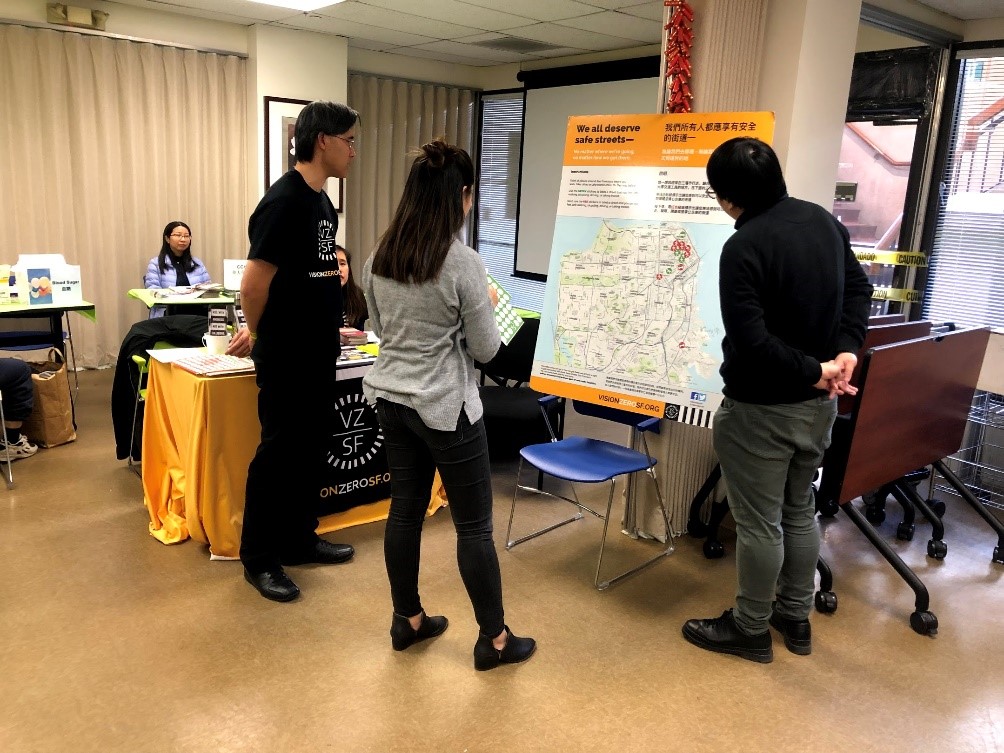
To achieve equitable outcomes and save lives, Vision Zero initiatives go deeper with multicultural communication and outreach so that we can uncover culturally-specific assumptions, barriers, and motivations that lead to more effective ways of reaching communities of concern.
Over the last couple of years, organizations and cultural consultants serving Chinese populations - as well as residents themselves - were involved in the development of this campaign. From outreach to focus groups and intercept surveys, the Chinese community shared traffic safety concerns, identified common channels for receiving information, and prioritized the visual look and messaging of the campaign.
The campaign plays on the Lunar New Year of the Rat theme as well as emphasizes the culturally celebratory colors of red and gold throughout the design. Here’s to a safe New Year for all San Francisco.
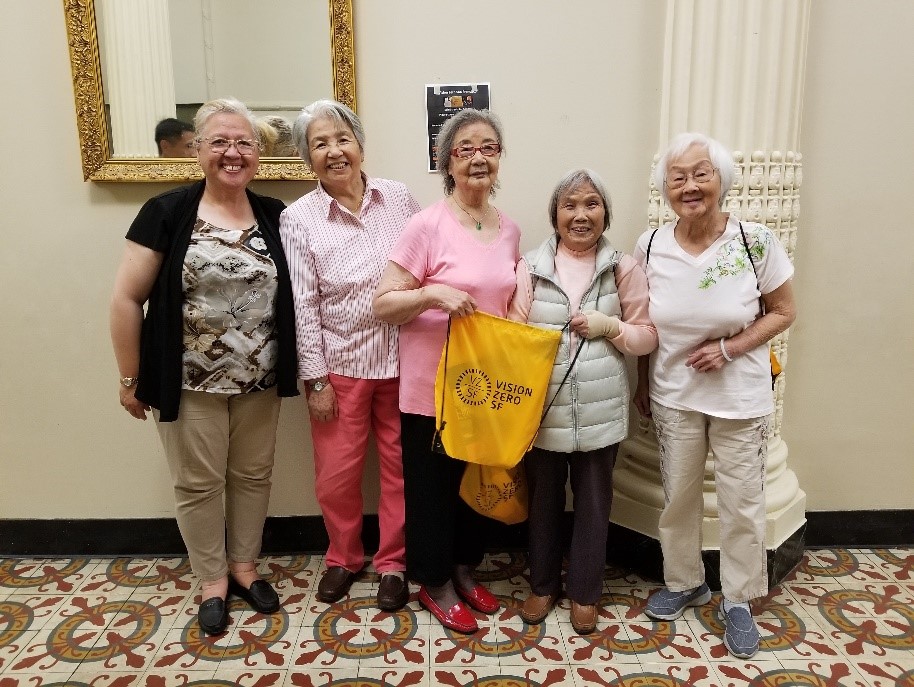
Where will people see this campaign? To reach the greatest number of people, the bulk of this campaign will be delivered through digital advertising and will connect with Chinese-speaking drivers through their devices (cell phones, laptops, etc.), especially drivers using Waze, Uber, and Lyft apps as well as those using WeChat. Paper advertisements will also be placed in Chinese-language newspapers.
Vision Zero SF is the city’s road safety policy that will build safety and livability into our streets, protecting the one million people who move about the city every day. San Francisco is committed to achieving our Vision Zero goal of zero traffic deaths.
To learn more about Vision Zero work visit visionzerosf.org
Show HN: Convos – Self hosted IRC chat https://convos.by/ February 19, 2020 at 02:51PM
Labels: Hacker News
Show HN: Demo Trivia App with React, TypeScript, Redux, React Router, Animations https://ift.tt/2P66P3i February 19, 2020 at 01:34PM
Labels: Hacker News
Show HN: Interactive Fitness App – using a video component to loop exercise reps https://ift.tt/2HFkMkE February 19, 2020 at 12:13PM
Labels: Hacker News
Show HN: Larq – Binarized Neural Network Inference with MLIR and TFLite https://ift.tt/37GlngQ February 19, 2020 at 11:04AM
Labels: Hacker News
Show HN: Ldapper – A simple, ergonomic Python ORM for interacting with LDAP https://ift.tt/2uYOa2K February 19, 2020 at 09:55AM
Labels: Hacker News
Launch HN: Goodcover (YC S17) – Cooperative Renters Insurance for Half the Price Hi HN, we’re Chris and Dan, co-founders of Goodcover ( https://ift.tt/2T4mCkG ). Goodcover provides renters insurance (only in California at the moment) and operates as a cooperative. We take a fixed fee on every policy, pool the premiums to pay claims, and then return what’s left over back to Members through an annual dividend. Thanks to this model and good technology we’re able to cut the price of renters insurance in half. I (Chris) worked in traditional insurance for 8 years. That time taught me to love insurance and how it picks people up after disasters, but it also gave me first hand exposure to the things people hate about it – the ever-increasing prices, the adversarial claims negotiations, the mountains of paperwork, and the byzantine decision making. All these inefficiencies kept us from really understanding and working for our policyholders – the people we were meant to serve. I became convinced technology was coming for this industry. I moved to SF in 2016, which is where I met Dan through a family friend. Dan had co-founded Cloudkick (YCW09) and was now looking to start another company. He also knew technology was coming for insurance, especially after his early career at IBM where he saw just how many “tech consultants” were placed in State Farm. Meeting him was a breath of fresh air – we started Goodcover in 2017 and got into YC right after. And then… it took us two years to get a product to market. We had opportunities to get going faster – you can get an agent’s license, buy off the shelf software, and sell other companies’ products in a matter of weeks. But they would be the same crappy, overpriced, adversarial products that everybody sells, and everybody hates. What good is that? Instead, we didn’t take the shortcuts and stuck it out to change the business model to cut the price in half, and Goodcover is the result. The story of how we did this starts with how insurance prices are made. If you have lots of claims data, you can run regressions to learn how underwriting factors like location, customer data, previous losses, etc all affect the frequency and severity of claims for every dollar of coverage you are providing. You then load that claims model with your expenses and desired profit margin, and boom you have insurance rates. You then have to get the Department of Insurance in each state you enter to sign off on your rates (not too low so you lose money, not so high that the government calls out your gouging). We knew technology would save us a lot on processing costs – with Dan’s technical background we knew that we could build technology that would run the business for a fraction of the cost that the typical industry vendors charge. We weren’t going to be saddled with huge agency forces or massive brand advertising. But, we didn’t have any claims data. Enter Quirk 1 of the insurance industry: all personal lines insurance pricing is public. Since all product and pricing is approved by the state government, to start something new you need to essentially reconstitute work other companies have done, proving that the elements you choose work for your target market. This is why most new insurance offerings are basically just another version of the pricing model sold by the “Insurance Services Office” (ISO – yes, that’s a company, not a government agency). It’s approved everywhere and used by everyone, so it’s a quick start. Lemonade uses ISO with one important modification: they set their minimum premium at $60 instead of $120, allowing them to claim an introductory price of $5 a month. If you buy more than the minimum coverage though, you’ll quickly get to “everybody else’s price” territory. However to cut the price without sacrificing coverage, we couldn’t use the same model that everyone else does. We needed a more granular model where we could charge the safest 99% people very little in exchange for charging the riskier 1% more. In my insurance career I had learned a lot about models designed for high-value homes, jewelry, cars etc – these models price in catastrophe (like hurricane and wildfire) very precisely to manage exposures in high-risk places. This granularity results in much lower prices for safer risks, since prices there don’t need to subsidize risky ones like they do in traditional “mass market” models. We decided to adapt these models to build our own that would be applicable to our target market, i.e. Renters. Our competitors that don’t use these models are in a bit of a pickle, because they can’t raise prices for high risks too fast thanks to regulatory constraints, meaning they have to keep prices high in safe places to balance the book. It also meant we could start with a coverage baseline that was better than the usual Renters Policy, including coverage for mold remediation, water damage originating from other peoples’ apartments, etc. We modernized the coverage, getting rid of extra coverage for things like oriental rugs and replacing it with more computer coverage. And critically we lowered the expense base, allowing us to offer huge savings thanks to the compound effect of lower costs and more granular pricing for our target market. The biggest apples-to-apples discount we’ve clocked so far is 71%. Custom model in hand, we were a critical step closer. But we still couldn’t offer insurance until we had the capital ready to pay claims. Insurance regulation sensibly makes sure that before you sell insurance to anyone you are adequately capitalized to pay your claims. Thus we set out to raise more capital. Here’s where we ran into Quirk 2, and something I should have known all along. Insurance Claims Capital is inherently not venturable. VCs look for 10-100x return on investment. But, as we grew the company, by law our claims capital reserves would always need to be at least 3x our expected losses (8x is normal). That geometric growth pattern is not scalable. Even if we raised over and over again, by the time we “made it big” we would be selling shares to normal investors, people who value insurance companies on a multiple of their cash on hand. Today’s insurance monsters have grown their cash base slowly for about 100 years. We found it was inefficient for us to own this capital, and therefore impossible to pitch. Money we raise should go to scaling our operations, not sitting around in case we had more claims than premiums. This meant we need to get claims capital partners – aka, rent it from insurance companies. We had hoped to avoid this because of quirk 3 of the insurance industry, “underwriting profits”. It used to be you could run an insurance business with huge expenses at a loss and make money because interest rates are great. No longer. The way insurance companies make money today is by keeping the difference of premium minus claims and expenses, or “underwriting profit”. This sets insurers up to be in conflict with their customers, and my experience in the industry showed me that if there was a root cause for all the reasons people hated insurance, this was it. So not only would we now need to ask insurers for help, we’d need them to give us their profit back to return to Members. This process took over a year. Fortunately we secured in-principle approval from a great reinsurer (TransRe) early on. The next step was to find a “primary” insurance partner to get us set up in California. We still have the chart of our emotions on the whiteboard in our office from that time – with huge ups (like when we moved to board-level conversations with one of California’s best cooperative insurers) to huge lows (like when those talks collapsed because that insurer’s agency force wouldn’t allow the channel conflict of a digital partner). Eventually we got it done, inking a three-party deal that worked for everyone, providing a more or less stable return for our capital partners but with the excess profit returning to Goodcover’s Members. With model and insurance capital partners in hand we then moved to get approval from California, which went as well as a process like that could, thank goodness. While we were working on these business objectives we built the necessary technology to service policies, quotes and maintain regulatory compliance. The easiest way to think of insurance is it works like an append only database. For instance, to remove coverage you would amend a person’s policy contract to remove a coverage, and so similarly in our tech stack we append an event that describes the changes to the policy which outputs a final policy. As a side benefit, this allows us to see the current state of a policy at any point in time. This model works well for us considering most, if not all, of our code is written in a functional language (Scala). Which brings us up to late last year when we wrote our first Goodcover policy. Honestly it’s been quite an ordeal, but we think the changes we’ve been able to implement have been worth it. I am so thankful for the hard work and persistence of the team, and for all the feedback and help the HN and YC community have given us over the years (shout out to anyone who remembers our “Advice” Show HN from 2018! - https://ift.tt/2zeHKh7 ). Renter’s insurance in CA is just the first step, (home and more states on the way) We have a ton more listening to Members to do, but we hope you enjoy the benefits – and are super grateful for any feedback you have! February 19, 2020 at 12:00PM
Labels: Hacker News
Show HN: The declarative way of documenting components https://pitsby.com February 19, 2020 at 11:51AM
Labels: Hacker News
Show HN: Hyvor Talk – a better way to add comments to blogs Hello HN! I'm Supun from Hyvor Talk ( https://talk.hyvor.com ), a commenting platform for websites. First, to be clear, Hyvor is the startup I'm building and Hyvor Talk is the first product of it. Here's how it started. I'm a PHP dev and I did a blog a little while ago. When it came to adding comments I didn't like the options available there for three reasons. 1. Some were not privacy-focused. They collected a bunch of user's data and placed ads on users' sites. 2. Most of them were not modern-looking. 3. Most of them were expensive. So, I created my own commenting system for my website with only comments and replies. After a few weeks, I thought it would be better if I could allow others to use this and solve the above 3 problems. So, in December 2019, I started working on this full time. Since then, I have developed many features (most of them are based on suggestions I got through our Discord server). Here are some features/facts about it. * It does not collect users' data. * It's fast because of no third party code, ads, etc. * It has a powerful AJAX-based moderation console. * It's completely free up to 40,000 page views per month. * It's fully customizable (colors, fonts, texts) - You can see some customized pages in our landing page. * It has a built-in spam detector. * I and my girlfriend (a graphic designer) worked hard to make the system as much as user-friendly and attractive. At the moment, I'm happy to say, 20+ websites use this commenting system actively. More than 1000 users have signed up as commenters. Thank you for checking this out! I'd love to hear your feedback. February 19, 2020 at 09:31AM
Labels: Hacker News
Show HN: Bootstrapping a community-based startup for AR creators. Catchar 2.0 https://www.catchar.io/ February 19, 2020 at 09:14AM
Labels: Hacker News
Show HN: Derek – automate GitHub and delegate to your OSS community https://ift.tt/2pQzLmf February 19, 2020 at 02:34AM
Labels: Hacker News
Show HN: iLert – one platform for uptime monitoring, alerting and being on-call https://www.ilert.com February 19, 2020 at 07:23AM
Labels: Hacker News
Show HN: Erase your support, employment from Lambda School from your Twitter https://ift.tt/2vKbTDO February 19, 2020 at 07:12AM
Labels: Hacker News
Show HN: Docs2Book – Distribute your Google Documents in a whole new way https://docs2book.com/ February 19, 2020 at 01:24AM
Labels: Hacker News
Show HN: Consultant Daily – An E-Mag for Consulting Professionals https://ift.tt/39Jw43s February 18, 2020 at 11:48PM
Labels: Hacker News
Show HN: Final Fantasy VII Running on Vulkan https://ift.tt/2SW085c February 19, 2020 at 05:38AM
Labels: Hacker News
Show HN: Code for: “interactive demo” from Trevor.io landing page https://ift.tt/2P7P2c5 February 19, 2020 at 03:04AM
Labels: Hacker News
Show HN: Know when your emails are opened https://mailpanion.com February 18, 2020 at 04:59PM
Labels: Hacker News
Show HN: Acmedns Authenticator Plugin for Certbot https://ift.tt/2SEx1US February 19, 2020 at 02:01AM
Labels: Hacker News
Show HN: Ahab – Dockerize your project, Git style https://ift.tt/2uWKGha February 18, 2020 at 07:13PM
Labels: Hacker News
SFMTA Public Meetings February 18 - March 2

Tuesday, February 18, 1 p.m.
City Hall, Room 400
Nearby Muni Routes: 5, 19, 21, 47, 49, F Market, Civic Center Station
The SFMTA Board of Directors provides policy oversight for the safe and efficient transportation of goods and services in San Francisco. This includes the San Francisco Municipal Railway (Muni), automobiles and trucks, taxis, bicycling and walking. The SFMTA Board of Directors also serves as members of the San Francisco Parking Authority.
Our board of directors meetings are usually held on the first and third Tuesdays of each month. The agenda includes presentations and discussions on adopting the Bayview Community Based Transportation Plan, the Fiscal Year 2021 and FY 2022 operating budget and the Curb Management Strategy.
Monday, February 24, 6 p.m.
City College San Francisco Mission Campus
Nearby Muni Routes: 9, 9R, 14 Mission, 24, 49, 67, J Church
Following a successful pilot implementation of parking-protected bike lanes between Market Street and 15th Street in spring 2019, the SFMTA began advancing design work between 19th Street and Cesar Chavez and has developed a draft design to share with the community.
Please stop by the open house anytime from 6 p.m. to 8 p.m. to share your public comment on the proposed changes. As part of the SFMTA’s Quick-Build Program, this open house will also serve as a public hearing. This next phase of improvements includes parking-protected bikeways, parking and loading changes, adding parking meters to side streets, left-turn restrictions, stop changes for the 12-Folsom and commuter shuttle program, and pedestrian improvements such as daylighting and advanced limits lines on Valencia Street from 19th Street to Cesar Chavez. Pending the approvals process, the improvements are anticipated to be installed in spring 2020. We look forward to seeing you there!
Our Meeting Round-Up feature highlights different SFMTA public meetings that will be held within the coming two weeks. These meetings give you the chance to share your ideas and provide us with helpful feedback. Join us at our next meeting to learn more about SF's changing and complex transportation system.
Those listed above are just a few highlights. You can find a full list of upcoming meetings to keep up to date on your favorite SFMTA committees.
Launch HN: API Tracker (YC W20) – Track and manage the APIs you use Hey HN! We’re Cameron, Trung and Matt from API Tracker ( https://ift.tt/38GoNBc ). We make tools to help with using third-party APIs in production. When software teams integrate with APIs they often run into outages, network issues, interface changes or even bugs that cause unexpected behavior in the rest of their system. These problems are hard to predict and prepare for so most teams don’t deal with them until there's a outage and have to do an emergency build to add logging and get to a root cause. This is what happened to us. Trung and I are both software engineers and we spent a lot of time and energy trying to make our API integrations robust and reliable in production. We found ourselves instrumenting all our API calls so we could know how many calls we were making, how long they were taking and if they were failing. We set up alerts for errors and latency increases and integrated with PagerDuty. We wrote retry logic with exponential backoff. We wrote failover from one API provider to another. At the end of it all we built a lot of tooling that required maintenance and wasn’t even applied uniformly across all of our integrations. After building all this infrastructure we realized that many other teams are reinventing the same wheel. To solve this problem we built an API proxy that takes requests and relays them to the API provider. By proxying this traffic we are able to instrument each call to measure latency, record status codes, headers and bodies, and add reliability features like automatic retry with exponential backoff. From there we can monitor and alert on issues and provide a searchable call log for debugging and auditability. We knew that because we were asking teams to run their mission critical API calls through us that we had to build a highly available and scalable proxy architecture. We’ve done this by designing a proxy that can be distributed across multiple regions and clouds. We are currently running out of AWS. Global Accelerator allows us to use their private internet backbone to quickly get traffic to our proxies which run behind AWS Network Load Balancers. While this can help us ensure resilience against infrastructure outages, we also need to protect against self-inflicted wounds like bugs and bad deployments. Upon release we bring up a new set of proxy instances, deploy the code, and run our full test suite to make sure that each instance is able to proxy requests correctly. Once all instances are healthy they begin to go into the load balancer. For companies with more stringent needs we support on-premise installations as well as a client-side SDK that can do instrumentation without the proxy. Today we offer the service as a subscription. We hope to make it easy for teams to get visibility and control across all their integrations without having to build it themselves. This includes: - Detailed logging on all of their third-party API calls - Monitoring and alerting for increased latency and error rates - Reliability features like automatic retry, circuit breaker and request queueing - Rate limit and quota monitoring We would love to hear from the community how you are managing your API integrations. Our story is a result of our experiences and how we dealt with them, but we know the HN community has seen it all. We would love to hear from you about problems you’ve had and how you dealt with them. Please leave a comment or send us an email to founders@apitracker.com. Looking forward to the discussion! February 18, 2020 at 12:00PM
Labels: Hacker News
Show HN: CoveTrader – Combines multiple crypto exchanges into one trade platform Our dev team recently launched CoveTrader at https://ift.tt/2V1JF1Z. Using our extensive experience from traditional financial markets, we connect to many crypto exchanges (Coinbase, Kraken, Bitstamp, etc.) and show aggregated order books, trade lists, and analytics in both real-time and historical formats. We currently support BTC, ETH, LTC, BCH, ETC, EOS, and XRP, but are adding more. It's currently just analytics, but we'll be adding order sending in Q2. Feedback and feature requests are welcome and can be sent to sknudsen@covemarkets.com. February 18, 2020 at 11:32AM
Labels: Hacker News
Show HN: FounderPhone – make customer support personal with SMS Hi HN! We're Parthi and Kunal from FounderPhone (https://ift.tt/39LIHew). FounderPhone is a shared customer support inbox for SMS and calls in Slack. We've built and shipped 7 products recently and if there's one thing we've learned, it's that your personal relationship with your customer is your secret weapon as a startup. Having customers email support@company.com or message a bot via Intercom doesn't feel personal. People are skeptical they will ever get a response. We've had a lot of success giving out our phone number to customers we really care about and telling them to text us whenever something comes up. Apparently, lots of great founders like Patrick from Stripe did this while growing their startups. The problem is that phone numbers aren't really meant for customer support and it gets overwhelming pretty quickly. So we hacked together a solution for ourselves where we made Slack a shared inbox. When a customer texts or calls me, our team can also see the messages and incoming calls. We can discuss how best to handle the issue in Slack and then anyone can respond via text. For calls, anyone available can redirect calls to their own number. From the customer's perspective, they're just texting a single number. They're not frustrated with messy tickets or being routed to 3 different people. They will always read your responses because it's in their SMS inbox instead of being lost amongst their 20,000 unread emails. This is just the start! We're looking into building a whole suite of software to make customer support feel both personal and immediate. We're making an integration with Segment and Sentry to alert you when a customer has an issue so you can reach out to them about it before they complain to you. Text our FounderPhone (510) 756-2522 with your name or email founders@founderphone.com if you have any questions. Thanks for checking us out! February 18, 2020 at 11:02AM
Labels: Hacker News